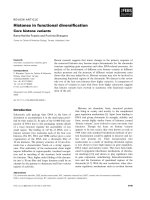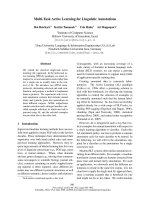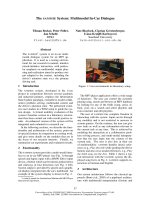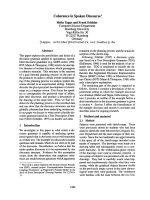Báo cáo khoa học: "MOVEMENT IN ACTIVE PRODUCTION NETWORKS" pot
Bạn đang xem bản rút gọn của tài liệu. Xem và tải ngay bản đầy đủ của tài liệu tại đây (402.08 KB, 6 trang )
MOVEMENT IN ACTIVE PRODUCTION NETWORKS
Mark A. Jones
Alan S. Driacoll
AT&T Bell Laboratories
Murray Hill, New Jersey 07974
ABSTRACT
We describe how movement is handled in a class of
computational devices called
active production networks
(APNs). The
APN model is a parallel, activation-basod
framework that ha= been applied to other aspects of
natural language processing. The model is briefly defined,
the notation and mechanism for movement is explained,
and then several examples are given which illustrate how
various conditions on movement can naturally be explained
in terms of limitations of the APN device.
I. INTRODUCTION
Movement is an important phenomenon in natural
languages. Recently, proposals such as Gazdar's dcrivod
rules (Gazdar, 1982) and Pereira's extraposition grammars
(Pereirao 1983) have attemptod to find minimal extensions
to the context-free framework that would allow the descrip-
tion of movement. In this paper, we describe a class of
computational devices for natural language processing.
called
active production networks (APNs),
and explore
how certain kinds of movement are handled. In particular.
we are concerned with left extraposition, such as Subject-
auxiliary Inversion.
Wh-movement,
and NP holes in rela-
tive clauses, in these cos•s, the extraposod constituent
leaves a trace which is insertod at a later point in the pro-
cessing. This paper builds on the research reported in
Jones (1983) and Jones (forthcoming).
7,. ACTIVE PRODUCTION NgrwoPJ~
7 1 Tim i~vk~
Our contention is that only a class of parallel devices
will prove to be powerful enough to allow broad contextual
priming, to pursue alternative hypotheses, and to explain
the paradox that the performance of a sequential system
often degrades with new knowledge, whereas human per-
formance usually improves with learning and experience. =
There are a number of new parallel processing (connection-
• st) models which are sympathetic to this view Anderson
(1983). Feldman and Ballard (1982), Waltz and Pollack
(1985). McClelland and Rumelhart (1981, 1982), and
Fahlman. Hinton and Sejnowski (1983).
Many of the connection•st models use iterative relaxa-
tion techniques with networks containing excitatory and
inhibitory links. They have primarily been used as best-fit
categorizers in large recognition spaces, and it is not yet
clear how they will implement the rule-governed behavior
of parsers or problem solvers. Rule-based systems need a
strong notion of an operating state, and they depend
heavily on appropriate variable binding schemes for opera-
tions such as matching (e.g unification) and recurs•on.
The APN model directly supports a rule-based interpreta-
tion, while retaining much of the general flavor of
I. 1"be htmmm li~ity to L:mrfofm mmlpatztmmtlly e•patm,m opmltmm =alia s
~y ~, imt'alkd loud,mum remforou this b¢fid.
connection•sin. An active production network is a rule-
oriented, distributed processing system based on the follow-
ing principles:
1. Each node in the network executes a uniform activa-
tion algorithm and assumes states in response to mes-
sage (,such as expectation, inhibition, and activation)
that arrive locally; the node can, in turn, relay mes-
sages, initiate messages, and spawn new instances to
process message activity. Although the patterns that
define a node's behavior may be quite idiosyncratic or
spocializod, the algorithm that interprets the pattern
is the same for each node in the network.
2. Messages are relatively simple. They have an associ-
ated time, strength, and purpose (e.g., to post an
expectation). They do
not
encode complex structures
such as
entire binding lists, parse trees, feature lists,
or meaning representations, z Consequently, no struc-
ture is explicitly built; the "result" of a computation
consists entirely of the activation trace and the new
state of the network.
Figure I gives an artificial', but comprehensive example
of an APN grammar in graphical form. The grammar
generates the strings a,
b. acd. ace. bed. bee. fg
and gl-
and illustrates mapy of the pattern language features and
grammar writing paradigms. The network responds to
$ourcex
which activate the network at its leaves. Activa-
tion messages spread '*upward" through the network. At
conjunctive nodes
(seq
and
and),
expectation messages are
posted for the legal continuations of the pattern; inhibition
messages are sent down previous links when new activa-
tions are recorded.
P
J~
Figure i. A Sample APN
In parsing applications, partially instantiatcd nodes are
viewed as phrase structure rules whose next constituent is
expected. The sources primarily arise from exogenous
2. For • sit'tatar ¢oaaectioaett vnew, ~ F¢ldman sad B#llard (1982) or
Waltz ted Pollack (198S). A compemoa or markor patuns, value
Imaan I •ad uoreltricted
melmzle
pinball =yttm=t= i= ipvea ia Fahlmnm,
Hlalal lad Scjnowl~ (IgS)).
161
strobings of the network by external inputs.
In
generation
or problem solving applications, partially instantiated nodes
are viewed as partially satisfied goals which have out.stand-
ing subgoaLs whine solutions are de=ired. The source= in
this case are endogenously generated. The compatibility of
the=e two views not only allows the same network to be
used for both parsing and generation, but also permits
procesu~ to share in the interaction of internal and exter-
nal sources of information. This compatibility, somewhat
surprisingly, turned out to be crucial to our treatment of
movement, but it is aLso clearly desirable for other aspects
of natural language processing in which parsing and prob-
lem solving interact (e.8., referenco resolution and infer-
en(~P.).
Each node in an APN is defined by a pattern, written
in the pattern language of Figure 2. A pattern describes
the me=age= to which a node rmponds, and the new mes-
sage= and internal state= that are produced. Each subpat-
tern of the form
($ v binding-put)
in the pattern for node
N is a variable binding site; a variable binding takes place
when an instance of a node in
binding-gat
activates a
reference to variable v of node N. Implicitly, a pattern
defines the set of state= and. state transitions for a node.
The ? (optiouality), + (repetition) and • (optional repeti-
tion) operators do not extend the expressiveness of the
language, but have been added for convenience. They can
be replaced in preprocessin8 by equivalent expre&sions, j
Formal semantic definitions of the m_~_~$e passing
behavior for each primitive operator have been specified.
pattern
::
binding-site
(seq pattern
)
(and
pattern
)
(or
pattern
)
(?
pattern)
(+
binding.site)
(.
binding-site)
binding-site
:: ($
vat binding-pattern)
binding.pauern
::
node
I (and
binding-pattern )
I
(or
binding-pattern )
Figure 7 The APN Pattern Language
An important distinction that the pattern language
makes is in the synchronicity* of activation signals. The
pattern (and ($ vl X) ($
v2 ]'3)
require= that the activa-
tion from X and F emanate from distinct network sources,
while the pattern
($
v (and X I"3) insists that instances
of
X and Y are activated from the same source. In the
]. The
enact chore= o(
cq~s'acors
in the pattern
tan|up it
t matewhat
~at= mine from the =!~=m~attma of the
APN
maciaa~.
4, -r~ ¢nulreat APN model allocate= ~ telueatmUy. The ten=
$yllgiteomlclly
reflC~lt thl fact thll t[~ ~ kicl~Uly o4 r t~
i~
m~se= can be Ioc~y COmlm '.,,I f~m tlm=r tiuw ~f ~ TI~
u kin| u the ,ctJvuua= pmau= rims [=== a~ugb to coacli~aa the network
bmmi, mai my, m0 scuvatmm. Alua'aaUvety, a,:Uvalma melal~ covid
emV tl~ mmr¢~ ideatiW =t as a4di,t* t l~ram, et~n. ia tl~ csm. m=Jme
aeuntiom cam a*su.hq~ ~ at
t t'' prom t'~h, ~ e( tit
iaaemmltal
cxp~¢ume ~mvtm,,_,~._ F.= re~l~iy illlequndeut i ,i o,m'lap
may nm po~ a p~Vlem.
graphical representation of an APN, synchrony is indicated
by a short tail above the subpattern expression; the
definition of U in Figure I illustrates both conventions:
(and ($
vl
(and
TI)) ($ v2 S)).
2.3 Am F ~m~
Figure 3 shows the stages in parsing the string
acd.
An
exogenous source
Exog-srcO
first activates a, which is not
currently supported by a source and, hence, is in an inac-
tive state. The activation of an inactive or inhibited node
give= rise to a new instance (nO) to record the binding.
The instance is effectively a new node in the network, and
derives its pattern from the spawning node. The activation
spreads upward to the other instances shown in Figure
3(a). The labels on each node indicate the current activa-
tion level, repreu:nted as an integer between 0 and 9,
inclusive.
PO(9)
qo(9)
c
I I
aO(9) I
I
Exog-~rc0(9) [Exog-srcJ
(a) trace structure after a
po(4)
Q0 c0(4) s
aO I
T
Exog-src0 Exog-srcl(9) d e f
Exog-src
(b)
trace structure after
ac
pO(9)
Q0
cO
S0(9)
I
Exog-src0 Exog-srcl d0(9)
J
Exog-src2(9)
(c) trace structzure after
acd
[~ple 3, Stalp=l in Parsing
acd
162
The activation of a node causes its pattern to be
4re)instantiated and a variable to be (re)bound. For exam-
pie. in the activation of
RO,
the pattern (seq ($ vi Q) (5
v2 c'9)
is replaced by (seq ($
vi
(or Q QO)) ($
v2 c)).
and
the variable
vl
is bound to (20. For simplicity, only the
active links are shown in Figure 3.
RO posts
an expecta-
tion message for node C which can further its pattern.
The source
Exog-secO is
said to be
supporting
the activa-
tion of nodea nO. QO.
RO and PO
above it, and the expecta-
tions or inhibitions that are generated by these nodes. For
the current paper we will assume that exogenous sources
remain fully on for the duration of the sentenco, s
In Figure 3(b), another exogenous source
Exog-srcl
activates c, which furthers the pattern for
RO. RO
sends an
inhibition message to QO, posts expectations for S, and
relays an activation message to P0, which rebind~ its vari-
able to
RO
and a~umes a new activation value. Figure
3(c) shows the final situation after d has been activated.
The synchronous conjunction of
SO
is satisfied hy
TO
and
dO. RO
is fully satisfied (activation value of 9), and PO is
re-satisfied.
1,4 Gramm~ Writbql P~Ulpm
The APN in Figure I illustrates several grammar writ-
ing paradigms. The situation in which an initial prefix
string (a or b) satisfies a constituent (P), but can be fol-
lowed by optional suffix strings
(cd
or
ce)
occurs frequently
in natural language grammars. For example, noun phrase
heads in English have optional prenominal and postnominal
modifiers. The synchronous disjunction at P allows the
local role of a or b to change, while preserving its interpre-
tation as part of a P. It is also simple to encode optional
prefixes.
Another common situation in natural language gram-
mars is specialization of a constituent based on some inter-
hal
feature.
Noun phrases in English, for exampl©, can be
specialized hy case; verb phrases can be specialized as par-
ticipial, tensed or infinitive. In Figure l, node S is a spe.
cialization which represents "Ts with d-ness or e-ness, but
not
f-heSS.'"
The specialization is constructed by a synchro-
nous
conjunction of features that arise from subtrees some-
where
below
the node to be
specialized.
The APN model also provides for node outputs to he
partitioned into independent classes for the purl~s¢~ ,~)f the
activation algorithm. The
nodes
in the classes form
levels
in
the
network and represent orthogonal systems
of
classification. The cascading of expectations from dilfcrent
I~els can implement context-sensitive behaviors such as
feature agreement and s':mantic sclectionai restrictiops.
This is described in Jones (forthcoming). In the next sec-
tion, we will introduce a grammar writing paradigm to
represent movement, another type of non context-fre¢
behavior.
$. It is interertins to sp~'ulatc: on the oOm~lUamC~ o( vsr~w relauua~q of
~hiu ¢al~m~l~Oe. Fundam,mt~l limitatmm in the allocatm of ~ may
be reJalod to limiuUmna in sluart term memory (~r buff're space in
dc'tl~iatMi¢ zzleJ¢l~ I¢¢ Matctul, 19BO). Lin|uilti¢ ¢emmzinUl ~ on
OoQM~tlt~l¢ IcqtStb oou~ be col=ted tO ~rl~ daca),. ~ |yntlcli¢
Mlzdca path
bebav~¢
mJlbl be
rclltad to accc.h=Itad iowr~
decay r.atmmd
by inbibitioo from
•
~up~mll bypmbmia. Anythin$ mum than • f,~m~
iJ ~tttre at ,hi=
3. MOVI~W NT
From the APN perspective, movement (limited here to
left-extrapnsition) necessitates the endogenous reactivation
of a trace that was created earlier in the process. To cap
ture the trace so that expectations for its reactivation can
be posted, we use the following type of rule: (seq (5
vl
X ) ($ v2
(and
X X-see Y) ).
When an instance,
XO,
first activatea this rule,
vl
is bound to
XO;
the second
occurrence X in the rule is constrained to match instances
of
XO,
and expectations for
XO, X-see
and Y are created.
No new exogenous source can satisfy the synchronous con-
junction; only an endogenous
X.src
can. The rule is simi-
lar to the notion of an X followed by a Y with an X hole in
it (cf. Gazdar, 1982).
NP-t raell CNP V V ]
I ?.~.<>.~ 7 p /
I ~.~e t~ N ~ ran cnasecl /
I a the ¢.~mOU ~ /
Figure 4. A Grammar for Relative Clauses
Figure 4 defines a grammar with an NP hoic in a rela-
tive clause; other type, s
of
[eft-extraposition are handled
analogously. Our treatment of relatives is adapted from
C'homsky and Lasnik (1977). The movement rule for S is:
(seq ($ vl (and
Cutup Re/
(or
Exog.src PRO-src)) ($ v2
(and
Rel Rel.src S))).
The rule restricts the first instance
of
Re/
to arise either from an exogenous relative pronoun
such as
which
or from an endogenously generated (phono-
logically null) pronoun
PRO.
The second variable is
satisfied when
Rei,src
simultaneously reactivates a trace of
the
Rel
instance and inserts an NP-tracc into an S.
It is instructive to consider how phonologically null pro-
nouns are inserted before we discuss how movement occurs
by trace insertion. The phrase,
[NP
the mouse [~ PRO="
that ]], illustrates how a relative pronoun
PRO
is
inserted. Figure 5(a) shows the network after parsing
the
cat.
When the complementizer
that
appears next in the
input,
PRO-src
receives inhibition (marked by downward
arrows in Figure 5(b)) from
Rel.CompO.
Non-exogenous
163
sources such as
PRO-src
and
Rel.src
are activated in con-
texts in which they are expected and then receive inhibi-
tion. Figure 5(c) shows the resulting network after
PRO-
src
has been activated, The inserted pronoun behaves pre-
cisely as an input pronoun with respect to subsequent
movement.
The trace generation necessary for movement uses the
same insertion mechanism described above. Figures 6(a)-
(d) illustrate various
stages
in parsing the phraso, [/vp the
cat [~" whichi [$
tl
ranll], in Figure 6(a), after parsing
the cat which,
synchronous expectations are posted for an
S which contains a reactivation of the
RelO
trace by
Rel.
see. The
signal sent to S by
Rei.src
will be in the form of
an
NP
(through
NP-trace).
Figure 6(b) shows how the input of
ran
produces inhi-
bition on
Rei-src
from
SI.
The inhibition on
Rei-src
caus~ it to activate (just as in the null pronoun insertion)
to try to satisfy the current contextual expectations. Fig-
ure 6(c) shows the network after
Rel-src
has activated to
supply the trace. The only remaining problem is that
Rel-src
is actively inhibiting itself through .~0. 6 When
Rel-src
activates again, new instances are created for the
inhibited nodes as they are re-activated; the uninhibited
nodes are simply rebound. The final structure is shown in
Figure
6(d).
it is interesting that the network automatically enforces
the restriction that the relative pronoun, complementizer
and subject of the embedded sentence cannot all be miss-
ing.
PRO
must be generated before its trace can be
inserted as the subject. Furthermore. since expectations
are strongest for the first link of a sequence, expectations
will be much weaker for the VP in the relative clause
(under S under S") than for the top-level
VP
under
SO.
The fact that the
device
blocks certai'n structures,
without explicit weli-formedness constraints, is quite
significant. Wherever possible, we would like to account
for the complexity of the data through the composite
behavior of a universal device and a simple, general gram-
mar. We consider the description of a device which embo-
dies
the appropriate principles more parsimonious than a
list
of
complex conditions and filters, and, to the extent
that its architecture is independently motivated by proc,'ss-
ink (i.e performance) considerations, of greater thcorctical
interestf
As we have seen, certain interpretations can be
suppressed by expectations from elsewhere in the network.
Furthermore, the occurrence of traces and empty consti-
tuents is severely constrained
because
they must be sup-
plied by endogenous sources, which
can
only suppurt a sin-
tie constituent at any given time. For NP movement,
these two properties of the device, taken together.
elfectively enforce Ross's Complex NP Constraint (Ross.
1967), which states that, "No element contained in a
6. Another ,~sy o4"
rut•inS thi,J iJ
that the noa~ynchroetM:ity of the two
vanaMea in the I~ttern hat ~ viohtted. The wdt-inhibittoa of • murcg
ocgtwt in othcnr conteat~ in the APN ft'tnM:lmek eve• for egolgno~t
toMt~eL
Is
net,aerita that contai• leJ't.rm;urtiv• cyr.t~ or ,endmSl~tm
tttaghn~nta (e.S PP
lUaghfl~'ltt),
tett-iahibltioa Call Ifiu naturally
U
the t~ult at nemum~ me-de~rmiaim~ ae.tctivatioe of • ~[-inhil~t~
mum d'egUvety Ixorgtva the aea-tyarJumigity ~ pmuwnt.
?. 1"I~ work 4
Margin
(1980)
iain
tJ~tm~&l~t.
sentence dominated by an NP with a lexLcal head noun
may be moved out of that NP by a transformation."
To see why this constraint is enforced, consider the two
kinds of sentences that an NP with a lexical head noun
might dominate. If the embedded sentence is a relative
clause, as in.
[pip
the rat [~" whichl [$ the cat [~" whichj
[S fj
chased/I]] likes fish]J], then
Rel.src
cannot support
both traces. If the embedded sentence is a noun comple-
ment (not shown in Figure 4). as in.
[NP
the rat [~"
whichi [S he read a report [~" that [$ the cat chased
fl]]]]], then there is only one trace
in the intended
interpretation,
but there is nondeterminlsm during parsing
between the noun complement and the relative clause
interpretation. The interference eaus¢,, the trace to be
bound to the innermost relative pronoun in the relative
clause interpretation.' Thus, the combined properties of
the device and grammar consistently block those structures
which violate the Complex NP Constraint. Our prelim-
inary findings for other types of movement (e.g., Subject-
auxiliary Inversion, Wh-movement, and Raising) indicate
that they also have natural APN explanations.
4. IMPLF.aMENTATION 8ml Fu'ruRg DIMF.CrlONS
Although the re.torch described in this summary is pri-
marily of a theoretic nature, the basic ideas involved in
using APNs for recognition and generation are being
implemented and tested in Zetalisp on a Symbolics Lisp
Machine. We have also hand-simulated data on movement
from the literature to design the theory and algorithms
presented in this paper. We are currently designing net-
works for a broad coverage syntactic grammar of English
and for additional, cascaded levels for NP role mapping
and case frames. The model has aLso been adapted as a
general, context-driven problem solver, although more work
remains to be done.
We
are considering ways of integrating iterative relaxa-
tion techniques with the rule-based framework of APNs.
This is particularly necessary in helping the network to
identify
expectation coalitions.
In Figure 5(a), for exam-
pie. there should be virtually no expectations for
Rel-src,
since it cannot satisfy any of the dominating synchronous
conjunctions. Some type of non-activating feedback from
the sources seems
to be
necessary.
S.
SUI~ARY
Recent linguistic theories have attempted to induce
general principles (e.g., CNPC. Subjacency, and the Struc-
ture Preserving Hypothesis) from the detailed structural
descriptions of earlier transformational theories (Chomsky,
1981),
Our research can be
viewed
as an
attempt tu
induce the machine that embodies theae principles. In this
paper, we have described a class of candidate machine~,
called
active production networks,
and outlined how they
handle movement as a natural way in which machine and
grammar interact.
The APN framework was initially developed as a plau-
sible cognitive model for language processing, which would
have real-time processing behavior, and extensive
8. Uhle tO
r~ ~,-~ i
¢oeskJs~ttmsJ
wb~t
rg~lto tO e.lp~t~om
q~t~nfftb~ tJr•~
tm heud ia s ~.tr tlmt ~ nemmtg.
164
so(4)
NPO(9)
VP
CNPO (9) "'"
o
s
theO
I
Exog-srcO
cat0(9) ~ " "
| L T
Comn
Exog-sr¢l (9) Ir~
/ .h4Ch PRO% \ that
for
(a) trace structure after
the cat
So(4)
NPO(9)
I
CNPO(9)
NO
~
VP
OetO
• I\ '
/ =,~ Rel -Com°O (4)
Re I ~ ~~
4=er0(9)
I
(b) trace structure after
the cat
that
NPO(4) vP
/
CNPO(4)
Oat0 NO
/ I
tneO catO
I l
ExOg-SrCO ~x Og-S¢'C !
SO(4)
/ _ ~ ~,
-Ico~,oo
~ 9 ) ~ ~"
~ NP-t r'ace
CNP
RelO(9) I [ ComglementtzerO I / .I
\1 ,.' o J
/ [ p~o-src( )[ g-
(c) trace structure after
the cat
PRO
that
.Figure 5. Relative Pronoun Insertion
contextual processing and learning capabilities based on a
formal notion of expectations. That movement also seems
naturally expressible in a way that is consistent with
current linguistic theories is quite intriguing.
REFERENCES
Anderson, J. R. (1983).
The Architecture of Cognition,
Harvard University Press, Cambridge.
Chomsky. N. (1981).
Lectures on Government and Bind-
ing.
Foris Publications, Dordrecht.
Chomsky, N. and Lasnik, H. (1977). "Filters and Con-
trol,"
Linguistic Inquiry
g, 425-504.
Fahlman, S. E. (1979).
NETL" A System for Represent-
ing and Using Real-World Knowledge.
MIT Press, Cam-
bridge.
Fahlman, S. E., Hinton, G. E. and Sejnowski, T. J.
(1983). "Massively Parallel Architectures for Ah NFTL,
Thistle, and Boltzmann Machines,"
AAAI.83 Conference
Proceedings.
Feldman. J, A. and Ballard, D. It. (1982). "Connection-
ist Models and Their Properties,"
Cognitive Science 6,
205-254.
Gazdar, G. (1982). "Phrase Structure Grammar,"
The
Nature of Syntactic Representation,
Jacubson and Pullum,
eds., Reidel, Boston, 131 - 186.
Jones. M. A (1983). "Activation-Based Parsi.g."
8th
IJCAI,
Karlsruhe, W. Germany, 678-682.
Jones, M.A. (forthcoming). submitted for publication.
Marcus. M. P. (1980).
A Theory of S),ntactic Recogni.
lion for Natural L,znguage,
M IT
Press,
Cambridge.
Pereira. F. (1983). "Logic for Natural Language
Analysis," technical report 275, SRI International. Menlo
Park.
Ross, J. R. (1967).
Constraints on Variables.in Syntax,
unpublished Ph.D. thesis, MIT, Cambridge.
Waltz. D. L. and Pollack, J. B. (1985). "Massively
Parallel Parsing: A Strongly Interactive Model of Natural
Language Interpretation,"
Cognitive Science,
9, 51-74.
165
SO(2)
VP
NPO(4)
/
CNPO(4)
OetO NO
tfleO
i I I'~c° .'P°(9.~ 1 s
I
i~tchO(t) • ll ~ riCl
CNI
SO(2)
NPO(4 ~*~='~''`mr~~ "
VP
/
CNPO(4)
OetO NO $0(4)
. I r~=o~ ~ i ~,(4)
Sxog life0 Exoo-srcl
I "~4#"
/ ~
I ~=lo / ~. ~ v=o(9)
[ li" / / t 1
I wntchO /NI IPICi
VO(9)
,.o <~.,/.; ~!°o<,,
(a) trace structure after
ihe cat which
(b) trace structure after
the cat which ran
NP0(9)
VP
/
CNP0(9)
0et0 NO SO(9}
~ o~,,oo
~,o:.,<, '4 ~ I
.o,<.~oo
/ I
I il;~o / < /<.o(,,
~
~,o,~y ,:°o
S0(9)
NP0{9) VP
/
CNPO(9)
'7
0et0 NO S0(9)
1
/ cato
tneO
I wn~c~O =n4cn00(9~NP-trace0(9) v0
~:
\//
,
Exog ranO
I
Exog-Sr¢3 pel-src(9)| Exog-src3
(c) trace structure just after
the cat which t ran
(d) final trace structure
l;igwe 6.
Parsin8 Rclativc Clauses
166









